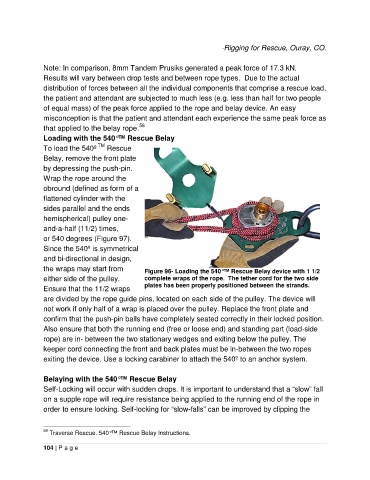Page 234 - Bài 1 ok_Neat
P. 234
-Rigging for Rescue, Ouray, CO.
Note: In comparison, 8mm Tandem Prusiks generated a peak force of 17.3 kN.
Results will vary between drop tests and between rope types. Due to the actual
distribution of forces between all the individual components that comprise a rescue load,
the patient and attendant are subjected to much less (e.g. less than half for two people
of equal mass) of the peak force applied to the rope and belay device. An easy
misconception is that the patient and attendant each experience the same peak force as
58
that applied to the belay rope.
Loading with the 540°™ Rescue Belay
To load the 540º TM Rescue
Belay, remove the front plate
by depressing the push-pin.
Wrap the rope around the
obround (defined as form of a
flattened cylinder with the
sides parallel and the ends
hemispherical) pulley one-
and-a-half (11/2) times,
or 540 degrees (Figure 97).
Since the 540º is symmetrical
and bi-directional in design,
the wraps may start from Figure 96- Loading the 540°™ Rescue Belay device with 1 1/2
either side of the pulley. complete wraps of the rope. The tether cord for the two side
Ensure that the 11/2 wraps plates has been properly positioned between the strands.
are divided by the rope guide pins, located on each side of the pulley. The device will
not work if only half of a wrap is placed over the pulley. Replace the front plate and
confirm that the push-pin balls have completely seated correctly in their locked position.
Also ensure that both the running end (free or loose end) and standing part (load-side
rope) are in- between the two stationary wedges and exiting below the pulley. The
keeper cord connecting the front and back plates must be in-between the two ropes
exiting the device. Use a locking carabiner to attach the 540º to an anchor system.
Belaying with the 540°™ Rescue Belay
Self-Locking will occur with sudden drops. It is important to understand that a “slow” fall
on a supple rope will require resistance being applied to the running end of the rope in
order to ensure locking. Self-locking for “slow-falls” can be improved by clipping the
58 Traverse Rescue. 540°™ Rescue Belay Instructions.
104 | P age

